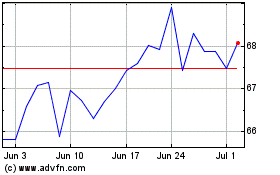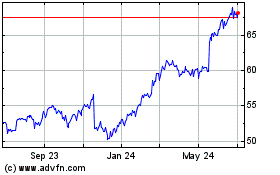Welcome to Walmart. The Robot Will Grab Your Groceries.
January 08 2020 - 11:29AM
Dow Jones News
By Sarah Nassauer
In the backroom of a Walmart store in Salem, N.H., is a
floor-to-ceiling robotic system that the country's largest retailer
hopes will help it sell more groceries online.
Workers stand on platforms in front of screens assembling online
orders of milk, cereal and toilet paper from the hulking automated
system. Wheeled robots carrying small baskets move along metal
tracks to collect those items. They are bagged for pickup later by
shoppers or delivery to homes.
Walmart is one of several grocers including Albertsons Cos. and
Kroger Co. that are using automation to improve efficiency in a
fast-growing but costly business that comes with a range of
logistical challenges.
The backroom robots could help Walmart cut labor costs and fill
orders faster and more accurately. It also could address another
problem: unclogging aisles that these days can get crowded with
clerks picking products for online orders.
A store worker can collect around 80 products from store shelves
an hour, estimated John Lert, founder and CEO of Alert Innovation,
the startup that has worked with Walmart to design the system
dubbed Alphabot. It is designed to collect 800 products an hour per
workstation, Mr. Lert said. Workers stock the 24-foot high machine
each day with the products most often ordered online, including
refrigerated and frozen foods. Fresh produce is still picked by
hand in store aisles.
A version of the Alphabot system will be built in the backroom
of two more stores later this year, one in Oklahoma and another in
California, and a fourth version of the system is already built in
a store near Walmart's headquarters, a Walmart spokesman said. Mr.
Lert and the spokesman declined to share the cost of the system.
Walmart started testing Alphabot in Salem two years ago, but in
recent weeks started using it to fill a significant portion of
online grocery orders for the first time.
Walmart, already the country's largest seller of groceries by
revenue, has become an online grocery heavyweight, too, by offering
a service from thousands of stores that lets shoppers pick up
online orders from store parking lots without leaving their cars.
It also offers home grocery delivery from more than a thousand
stores.
Online orders are still a relatively small part of total grocery
spending. E-commerce was about 3.5% of overall food and beverage
category sales last year, according to market researcher Forrester.
Some data show online grocery sales are growing fast, but the
logistical and profit challenges of asking workers to select food
for shoppers or delivering fresh food to homes have kept retailers
battling to find a model that works.
Using store workers to manually collect products from shelves
isn't only costly, it makes it hard to tell online shoppers exactly
what's available at any given moment.
"The whole problem with picking inventory from the shelf is
inventory is never where it's supposed to be," said Sucharita
Kodali, retail analyst at Forrester. "People move it around, and
fast-moving items are never there."
Walmart, which employs around 1.5 million workers in the U.S.,
told investors last year that the retailer aimed to add automation
and remodel stores to better accommodate online orders after some
shoppers complained about clogging in the aisles. Walmart can't
"disadvantage our most profitable customer, which is the one who
drives to the store and does all the work themselves," then-Walmart
U.S. chief Greg Foran said at the time.
Albertsons, whose chains include Safeway and Jewel-Osco, is
adding automated online grocery fulfillment devices in store
backrooms designed by Takeoff Technologies. It added two of the
systems to California Safeway stores last year. Kroger and
Koninklijke Ahold Delhaize NV's online grocery unit, Peapod, are
investing in larger, more-remote distribution centers to further
automate the process of grocery delivery.
Using stores and backrooms to collect online grocery orders
gives retailers another way to generate income from assets they
already have, industry consultants and executives say. Walmart also
has been looking for other ways to use its existing base of around
4,700 U.S. stores to compete with Amazon.com Inc., including adding
more services like health care and selling technology like
computing power based in stores to other businesses.
Walmart first talked to Alert Innovation about building an
automation system in 2016, Mr. Lert said. At the time, Walmart
executives believed that for online grocery fulfillment to become
more profitable, fulfillment had to happen close to customers and
without sending workers weaving through aisles for every order, Mr.
Lert said.
Walmart added 20,000 square feet of space to the Salem store to
facilitate the Alphabot system and more space for shoppers to pick
up orders in cars. It picked Salem because of its proximity to
Alert's headquarters in North Billerica, Mass.
The store hired around 10 additional people to keep the machine
stocked and continue picking some fresh produce from the store
shelves, the Walmart spokesman said. "At this point we haven't seen
any movement in the head count."
In a continued test of the concept, the spokesman said, the two
additional stores where Walmart plans to install Alphabot are in
areas with high demand for online grocery orders.
Write to Sarah Nassauer at sarah.nassauer@wsj.com
(END) Dow Jones Newswires
January 08, 2020 11:14 ET (16:14 GMT)
Copyright (c) 2020 Dow Jones & Company, Inc.
Walmart (NYSE:WMT)
Historical Stock Chart
From Mar 2024 to Apr 2024

Walmart (NYSE:WMT)
Historical Stock Chart
From Apr 2023 to Apr 2024
